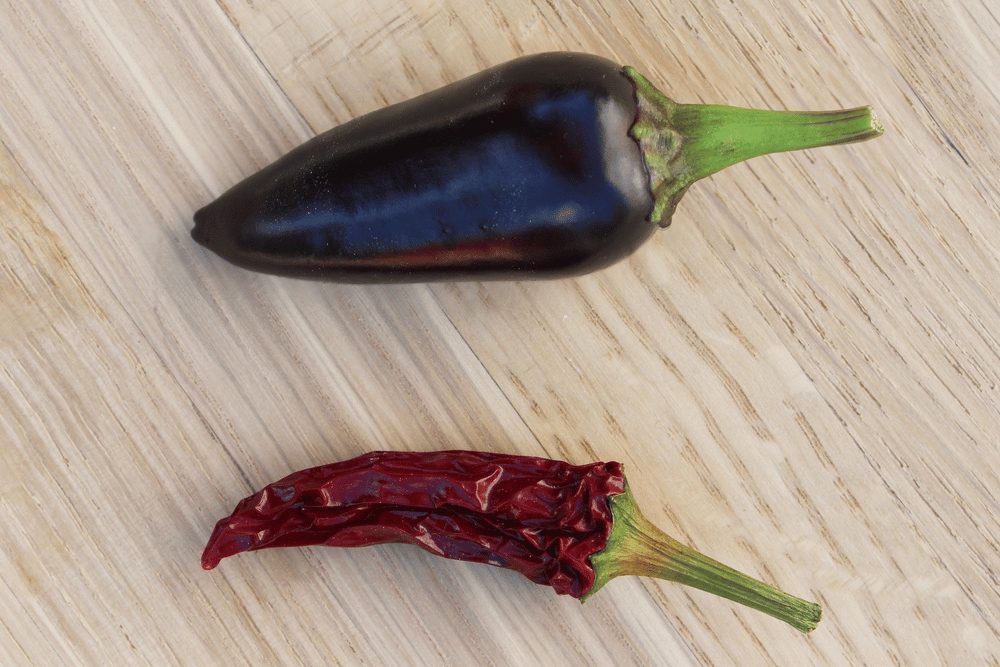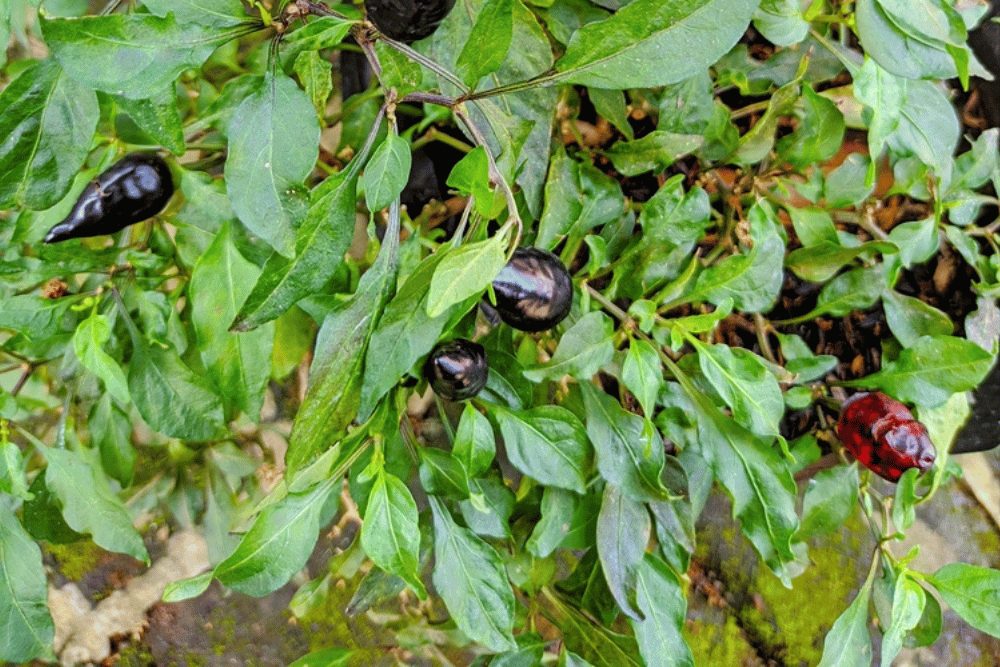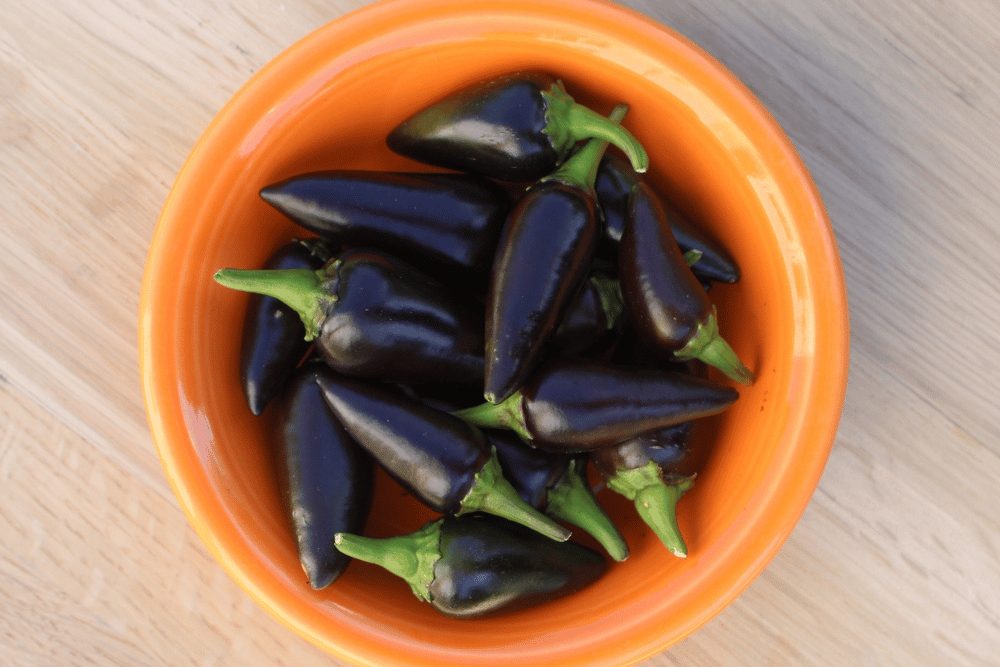If you like a little drama and beauty with your peppers, the black Hungarian pepper should be on your wish list. This unusual member of capsicum annuum is both ornamental and flavorful. Originating in Kiskenfelegyhaza, an area now part of modern-day Hungary, this Hungarian heirloom chili is prized for its appearance and rarity.
What Are Black Hungarian Peppers?
Black Hungarian peppers are ornamental pepper plants that produce beautiful purple flowers and black-colored fruit. The peppers take the shape of a jalapeno but are thicker-skinned and distinct in their sweet flavor.
Like other black ornamental peppers, they change in color as they age, going from green to dark purple, black, and deep red.
Their flavor and heat intensify as they mature, going from very little heat with bell pepper-like flavor while young, to a mild, sweet heat when red.
Black Hungarian Quick Facts
Origin: Kiskenfelegyhaza, an area that’s now part of modern-day Hungary.
Color: Begins green and changes to purple, then black, then deep red at full maturity.
Flavor: Mild heat with a crisp, sweet flavor. Flavor intensifies with age.
Size: 2-3 inches.

Can You Eat Black Hungarian Peppers?
Black Hungarian peppers are edible with a bright, crisp flavor that becomes sweeter and more intense with age.
In the early stages, while the pepper is still green, its flavor is reminiscent of green bell pepper, and the heat level is minimal. The flavor is more profound when the chili pepper has turned a shiny black and the heat level is higher.
Is a black Hungarian pepper hot?
Black Hungarians are not among the hottest peppers in the world, but they pack a nice punch of heat.
On the Scoville heat scale, black Hungarian peppers measure 5,000 – 10,000 SHUs (Scoville heat units). This puts them in a similar heat range to the jalapeno, but a bit hotter.
The chart below clarifies where the black Hungarian pepper ranks relative to other well-known pepper varieties:
- Habanero pepper, 100,000-350,000 SHUs
- Serrano pepper, 10,000-25,000 SHU
- Cayenne pepper, 15,000-20,000 SHU
- Black Hungarian pepper, 5,000-10,000 SHU
- Jalapeno pepper, 2,000-8,000 SHU
- Bell pepper, 0 SHU
Because of their mild heat, sweet flavor, and unusual beauty, black Hungarian peppers can make an excellent alternative to the more common jalapeno.
What can you do with Black Hungarian peppers?
These black peppers are perfect for making a statement in food presentation and flavor. They can be used in any recipe that calls for mild peppers.
Although black on the outside, black Hungarian pepper is green on the inside. This contrast can be striking when added to salads and salsas raw.
Because the pepper walls are thicker, black Hungarians are well suited for roasting or grilling. They make an excellent side dish with a bit of lime squeezed over them.
They’re also perfect for pickling, making a lovely appetizer, or addition to a charcuterie board.
If you enjoy making homemade hot sauce, check out this recipe with red and black Hungarian peppers, plus orange jalapenos for an extra kick and vibrant color.
If you’re not interested in eating them, black Hungarian peppers make a lovely addition as an ornamental plant in your garden.
Where To Buy Black Hungarian Peppers
This heirloom pepper isn’t easily found in mainstream grocery stores. It’s unlikely that you’ll find it in specialty stores, either.
How Do You Grow Black Hungarian Peppers?
If you’re hoping to add black Hungarian peppers to the menu, you’ll probably need to grow them yourself. The good news is that growing them isn’t difficult. Black Hungarian pepper seeds can be ordered from many online retailers.

When growing black Hungarian peppers from seed, it’s best to start them indoors approximately 8 weeks before the last frost. Doing this will allow the seedlings to get a good start before being transplanted outside.
To effectively do this, ensure that the soil temperature stays warm (80-85 degrees Fahrenheit) and moist. If you’re in a colder area, you may need a heat mat to keep the soil at the right temperature. They also do best with bright sun for the majority of the day. Under these conditions, you can expect germination 6-12 days after planting.
Once the danger of frost has passed, transplant outdoors.
Black Hungarian pepper plants prefer full sun and spacing of 12-24 inches to stretch their arms.
Plants can grow upwards of two feet high and may need staking as they mature. This will ensure plenty of room for the fruit to grow and ripen.
Peppers can be picked at any stage. But to get the most out of these peppers, you should wait until they turn black.
Black Hungarian pepper plants are fragile. When harvesting the fruit, it’s best to use scissors and snip off the small portion of the plant to which the pepper is attached. Pulling or snapping off the pepper is likely to damage the plant.
Black Hungarian Pepper Substitutes
Very few peppers make the same kind of visual statement that black Hungarians do, but the black pearl pepper comes close. Unfortunately, this beautiful ornamental pepper can also be challenging to find unless you grow it.
When it’s a matter of flavor, and heat jalapeno peppers can make a suitable alternative.
What are the benefits of black Hungarian peppers?
Regularly eating hot peppers comes with many health benefits.
They:
- Aid digestion
- Speed up metabolism
- Fight inflammation
- Have anti-microbial properties
Black Hungarian peppers have high levels of vitamins C and B, as well as copper and manganese.

